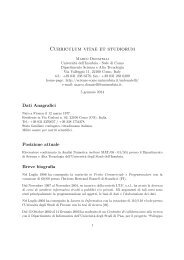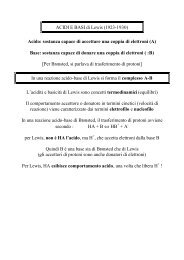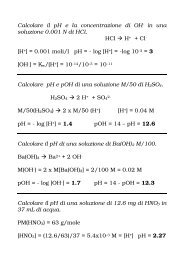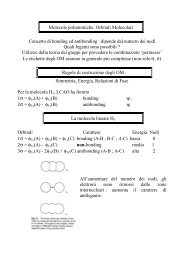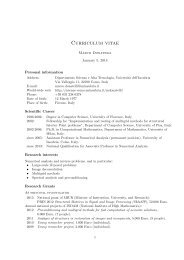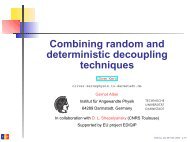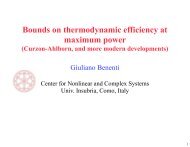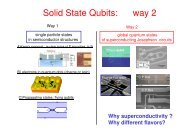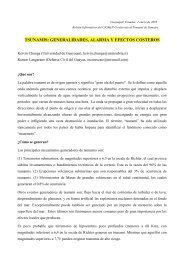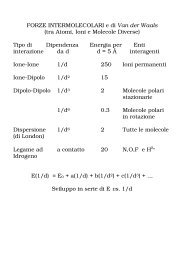Quantum Monte Carlo - ResearchGate
Quantum Monte Carlo - ResearchGate
Quantum Monte Carlo - ResearchGate
Create successful ePaper yourself
Turn your PDF publications into a flip-book with our unique Google optimized e-Paper software.
JOURNAL OF CHEMICAL PHYSICS VOLUME 112, NUMBER 2 8 JANUARY 2000<br />
<strong>Quantum</strong> <strong>Monte</strong> <strong>Carlo</strong> investigation of small 4 He clusters<br />
with a 3 He impurity<br />
Dario Bressanini a) and Matteo Zavaglia<br />
Dipartimento di Scienze Chimiche, Fisiche e Matematiche, Universitá dell’Insubria, Polo di Como,<br />
via Lucini 3, 22100 Como, Italy<br />
Massimo Mella b) and Gabriele Morosi c)<br />
Dipartimento di Chimica Fisica ed Elettrochimica, Universitá degli Studi di Milano, via Golgi 19,<br />
20133 Milano, Italy<br />
Received 27 July 1999; accepted 13 October 1999<br />
Small helium ( 4 He) clusters containing the lighter isotope 3 He are studied by means of quantum<br />
<strong>Monte</strong> <strong>Carlo</strong> methods. Accurate ground state energies and structural properties are obtained using<br />
accurate trial wave functions and the Tang–Tonnies–Yiu TTY helium–helium pair potential. The<br />
dimer 4 He– 3 He is not bound; as well as the trimer 4 He 3 He 2 . The smallest cluster containing 3 He is<br />
4 He 3 2 He with a nonrigid structure having a marked linear contribution. Interestingly, this weakly<br />
bound system, with an energy one order of magnitude less than the 4 He 3 trimer, is able to bind<br />
another 3 He atom, forming the tetramer 4 He 3 2 He 2 , which shows the odd feature of having five out<br />
of six unbound pairs. In general, the substitution of a single 4 He atom in a pure cluster with a 3 He<br />
atom leads to an energetic destabilization, as the pair 4 He– 3 He is not bound. The isotopic impurity<br />
is found to perturb only weakly the distributions of the remaining 4 He atoms, which retain the high<br />
floppiness already found in the pure clusters. As the number of atoms increases the isotopic impurity<br />
has the marked tendency to stay on the surface of the cluster. This behavior is consistent with the<br />
formation of the so-called ‘‘Andreev states’’ of a single 3 He in liquid 4 He helium and droplets,<br />
where the impurity tends to form single-particle states on the surface of the pure 4 He. © 2000<br />
American Institute of Physics. S0021-96060030802-9<br />
I. INTRODUCTION<br />
ture becomes ill defined. Recent efforts have been directed<br />
towards the development of methods that treat all the<br />
coupled internal degrees of freedom and towards the determination<br />
of accurate two-body potentials from which one<br />
can build an approximate, but hopefully rather accurate,<br />
many-body potential. The question of how important are<br />
three- and many-body effects in the description of the cluster<br />
is still an active field of research.<br />
The combination of the extremely weak interaction between<br />
helium atoms and the small atomic mass makes helium<br />
clusters very weakly bound and by far the most intriguing<br />
van der Waals clusters with highly quantum features. 2–5<br />
The most interesting feature is with no doubt the possibility<br />
to attain a superfluid state with a relatively small number of<br />
4 He atoms. 6–8 The superfluidity in helium clusters and the<br />
low temperature can be fruitfully exploited to perform highresolution<br />
vibrational and rotational spectroscopy on impurities<br />
and to study molecular reaction dynamics of chemical<br />
reactions. In a recent experiment, for example, the electronic<br />
spectra of the aminoacids tryptophan and tyrosine 9 were simplified<br />
by cooling their vibrational motion inside an helium<br />
droplet, allowing an easier interpretation of the experimental<br />
results.<br />
It is also possible to use an atom or a molecule as a<br />
probe to study the local environment of the clusters: to this<br />
end a great variety of atoms and molecules has been included<br />
in the clusters.<br />
The systems formed by the two helium isotopes, evena<br />
Electronic mail: dario@fis.unico.it<br />
b Electronic mail: Massimo.Mella@unimi.it<br />
c Electronic mail: Gabriele.Morosi@unimi.it<br />
In recent years weakly bound atomic and molecular clusters<br />
have attracted the attention of a growing number of experimentalists<br />
and theoreticians. They offer the unique opportunity<br />
to study how matter properties change as a function<br />
of the number of atomic and molecular species in the cluster,<br />
bridging the gap between isolated gas phase species and bulk<br />
matter limit. 1 Clusters containing an impurity can be useful<br />
to study at the microscopic level the effect of the solvent on<br />
the solute. From the experimental side, the availability of<br />
techniques for synthesizing clusters of variable size has<br />
opened up new directions of research. Clusters of the desired<br />
size are now produced by free jet expansion of the corresponding<br />
gases. Since the expansion cools the gas below the<br />
condensation temperature, by adjusting the pressure it is possible<br />
to stop the condensation when the clusters reach the<br />
desired size. These clusters can, eventually, pick up an impurity,<br />
and then be probed using a variety of spectroscopic<br />
techniques. From the theoretical side, the main obstacle to an<br />
accurate first-principle study comes from the failure of the<br />
harmonic approximation and normal mode analysis. van der<br />
Waals clusters are not rigid structures that vibrate around an<br />
equilibrium configuration; rather, they show large-amplitude<br />
motions, and even the intuitive notion of equilibrium struc-<br />
0021-9606/2000/112(2)/717/6/$17.00 717<br />
© 2000 American Institute of Physics
718 J. Chem. Phys., Vol. 112, No. 2, 8 January 2000 Bressanini et al.<br />
tually doped with an atomic or molecular impurity, are of<br />
particular interest. Since the helium–helium interaction potential<br />
does not distinguish between the two isotopic species,<br />
it is possible to study effects entirely due to the zero-point<br />
motion of the species and to the different obeying statistics.<br />
A great deal of work has been devoted to the study of<br />
4 He/ 3 He liquid mixtures and to the investigation of a single<br />
fermionic helium in liquid 4 He. 10–13 In the liquid phase, below<br />
the tricritical point temperature, increasing the concentration<br />
of 3 He results in the separation of the mixture in two<br />
phases; a 4 He- and a 3 He-rich phase. For T→0 the 3 He solubility<br />
in 4 He reaches a finite value. The 3 He atom, being<br />
lighter, tends to move in regions of low 4 He density. For<br />
systems with a free surface, the fermionic atoms have the<br />
tendency to move to the surface, where they experience an<br />
effective potential and form the so called Andreev states. 14<br />
With the availability of modern diffraction techniques<br />
from a transmission grating, the study of mixed 4 He/ 3 He<br />
droplets has received a major impetus, both theoretical and<br />
experimental. 5,15–19<br />
Theoretical studies of mixed 4 He/ 3 He droplets, using<br />
density functional 15 or variational <strong>Monte</strong> <strong>Carlo</strong> techniques, 16<br />
predicted the formation of Andreev states on the surface of<br />
medium size droplets. They also showed that the binding<br />
energy of the 3 He surface states approaches the binding energy<br />
of 3 He atoms on a planar 4 He surface, as the number of<br />
atoms is increased.<br />
Surprisingly, while there has been a large theoretical effort<br />
in the accurate study of pure 4 He and 3 He small clusters,<br />
very little has been done towards the investigation of small<br />
mixed 4 He N 3 He M clusters. With the exception of the studies<br />
on the trimers 4 He 3 , 4 He 2 3 He, and 4 He 3 He 2 , 20–26 results for<br />
other small systems are scattered 27,28 and, to our knowledge,<br />
there are no accurate investigations using one of the modern<br />
helium–helium interaction potentials.<br />
In this work we study the energetics and structure of the<br />
ground state of the 4 He N 3 He clusters using quantum <strong>Monte</strong><br />
<strong>Carlo</strong> QMC techniques. In the past decade, QMC methods<br />
have been invaluable in providing a clear picture of highly<br />
quantum clusters of hydrogen and helium, both pure and<br />
doped with an impurity. 2–5,29–39 Here we use QMC methods<br />
to understand the structure of these systems, by computing<br />
various distributions of the two helium isotopes.<br />
The rest of the paper is organized as follows: Sec. II<br />
gives a brief description of the theoretical approach and the<br />
computational methods used. Section III contains a discussion<br />
of our results, while Sec. IV reports our conclusions and<br />
possible future directions of this study.<br />
II. COMPUTATIONAL METHODS<br />
It has become clear in the last few years that the only<br />
methods able to accurately estimate the properties of highly<br />
quantum clusters are the quantum <strong>Monte</strong> <strong>Carlo</strong> methods.<br />
They have been successfully employed in the past in the<br />
study of pure and doped helium clusters and are well described<br />
in the literature. For this reason we summarize here<br />
only the main points of the methods that are relevant to the<br />
discussion of this work, while we redirect the reader to the<br />
vast literature on the subject for more technical details and<br />
for a review of the applications of these methods. 40–43<br />
In atomic units, the Hamiltonian operator for the mixed<br />
4 He N 3 He M cluster is<br />
N<br />
2<br />
Ĥ 1 2<br />
<br />
i1<br />
<br />
m 4<br />
<br />
i1<br />
M<br />
<br />
2<br />
m 3VR,<br />
where V(R) is the interaction potential between the helium<br />
atoms and R is a point in configuration space that represents<br />
the position of all the species. For the atomic masses we used<br />
m 4 7296.12 amu and m 3 5497.88 amu. Here we assume a<br />
potential of the form,<br />
VR<br />
i j<br />
V He–He r ij ,<br />
where r ij is the distance between two helium atoms and<br />
V He–He (r) is the two body interaction potential. We explicitly<br />
exclude three-body terms which are believed to be unimportant<br />
for small helium clusters. We use the recently developed<br />
Tang–Tonnies–Yiu potential 44 TTY for the pair<br />
interaction. This potential, which is not based on any kind of<br />
empirical information, has been used recently by Lewerenz 32<br />
in his study of small pure 4 He clusters. We chose it in order<br />
to more easily check our computer code by comparing our<br />
results for pure clusters with those published. This potential<br />
is known to give a slightly weaker binding, in comparison<br />
with the less recent and more commonly used HFD-BHe<br />
potential, 45 likely owing to the stronger repulsion term.<br />
These small differences should not affect the results of this<br />
work. Notice that the interaction potential between two helium<br />
atoms is the same regardless the masses, so any effect<br />
on the energetics and structure of the mixed clusters<br />
4 He 3 N He M , as long as M3, should be ascribed only to the<br />
different zero-point motion of the two species. For M3<br />
effects due to the different obeying statistics become important.<br />
We approximate the ground state wave function of the<br />
cluster 4 He 3 N He with the pair-product form<br />
N<br />
T R<br />
i j<br />
r ij <br />
k<br />
N<br />
r k ,<br />
where r ij is the distances between two 4 He atoms while r k is<br />
the distance between the 3 He impurity and a 4 He atom. For<br />
the pure cluster we simply omit the impurity product. Both<br />
the (r) and (r) functions have the same analytical form,<br />
rrexp p 5<br />
r 5 p 2<br />
r 2 p 0 lnrp 1 r , 4<br />
which has been used with success for the description of small<br />
helium clusters by several workers. 32,39,46 We found unnecessary<br />
to include one-body functions; as a result the trial<br />
wave function is translationally invariant and this guarantees<br />
that we are not introducing any spurious kinetic energy of<br />
the center of mass. The chosen form for the trial wave function<br />
makes impossible to compute analytically the matrix<br />
element of the Hamiltonian operator, so a numerical method<br />
must be used to estimate the variational energy and other<br />
properties for a given choice of the eight parameters. An<br />
1<br />
2<br />
3
J. Chem. Phys., Vol. 112, No. 2, 8 January 2000 Small 4 He– 3 He clusters<br />
719<br />
integration method well suited for high dimensional spaces is<br />
the <strong>Monte</strong> <strong>Carlo</strong> method. Its practical application to the computation<br />
of the variational energy of a given trial wave function<br />
is called variational <strong>Monte</strong> <strong>Carlo</strong> 40,41,43 VMC. The<br />
VMC approach is a very powerful technique that estimates<br />
the energy and all the desired properties of a given trial wave<br />
function without any need to compute analytically the matrix<br />
elements. For this reason, it poses no restrictions on the functional<br />
form of the trial wave function, requiring only the<br />
evaluation of the wave function value, its gradient, and its<br />
Laplacian, and these are easily computed. Although the<br />
VMC approach, with a proper choice of the trial wave function,<br />
can give very good results by itself, in this work it has<br />
been mainly used to optimize a good trial function to be<br />
subsequently employed in a diffusion <strong>Monte</strong> <strong>Carlo</strong> DMC<br />
simulation which is able to estimate the exact ground state<br />
energy of the cluster.<br />
All the mean values are computed by using the formula<br />
O f RO locRdR<br />
, 5<br />
f RdR<br />
where<br />
O loc R O TR<br />
6<br />
T R<br />
and f (R) 2 T (R) for VMC while f (R) T (R) 0 (R) for<br />
DMC, 0 (R) being the exact ground state wave function.<br />
The optimization is performed using the standard fixed<br />
sample sigma minimization algorithm, introduced by Frost 47<br />
and Conroy 48 and recently described by Umrigar, Wilson,<br />
and Wilkins. 49 This is the standard way to optimize trial<br />
wave functions using VMC. Briefly, the mean square deviation<br />
of the local energy H/ is minimized, rather than the<br />
energy itself, since this leads to a numerically more stable<br />
process. The fluctuation of the local energy 2 (H)H 2 <br />
H 2 is computed using an ensemble of points or walkers<br />
distributed in configuration space. After the optimization has<br />
produced a new function, a VMC simulation is performed to<br />
estimate the new trial energy and to generate a new ensemble<br />
of walkers, to be used eventually in a new optimization.<br />
Usually convergence is achieved in three or four steps.<br />
III. RESULTS AND DISCUSSION<br />
In order to check our computer code, we have recomputed<br />
the energies of pure helium clusters for N2 – 7 using<br />
the wave functions optimized by Rick, Lynch, and Doll 4 and<br />
recently used by Lewerenz. 32 The DMC energies are in optimal<br />
agreement with those obtained by Lewerenz, our results<br />
have a smaller error bar as a result of longer simulations.<br />
We also optimized the wave functions for 4 He 11 and<br />
4 He 20 in order to compare these slightly larger pure clusters<br />
with those containing an impurity. As to the clusters containing<br />
an impurity, their wave functions have been optimized<br />
starting from the wave functions of the corresponding pure<br />
clusters. A minimum of 5000 configurations has been used<br />
during the optimization steps and for the VMC and DMC<br />
simulations. A time step of 200 hartree 1 has been employed<br />
for all the DMC simulations and we checked that the time<br />
TABLE I. DMC and VMC energies cm 1 for He N and 4 He 3 N1 He<br />
clusters.<br />
N DMC 4 He N VMC 4 He N1 3 He DMC 4 He N1 3 He<br />
2 0.000891<br />
3 0.087847 0.006662 0.009845<br />
4 0.38861 0.191992 0.20621<br />
5 0.90153 0.574846 0.63262<br />
6 1.60774 1.15052 1.26264<br />
7 2.48057 1.85952 2.07185<br />
11 7.2861 5.9753 6.6794<br />
20 23.041 19.981 22.2349<br />
step bias was within the statistical error of the calculations<br />
by performing a few simulations with a smaller time step.<br />
The trial wave functions employed in this work are only an<br />
approximation to the exact ground state wave functions, and<br />
give only approximate estimations of the true properties of<br />
these clusters. In order to project out the remaining excited<br />
states contributions we used the DMC method to sample the<br />
distribution f (R) T (R) 0 (R) which, using Eq. 5, allows<br />
the estimation of the exact ground state energy. In the<br />
DMC method, the mixed estimator does not give the exact<br />
values for operators that do not commute with the Hamiltonian,<br />
but only an approximation, albeit more accurate than<br />
the VMC estimate. For these properties, namely radial distributions,<br />
we give a more correct estimation using the so<br />
called ‘‘second order estimation’’ SOE,<br />
O SOE 2O DMC O VMC .<br />
7<br />
This gives an estimate of O that is second order on the error<br />
of the trial wave function.<br />
The energy estimates of the DMC simulations of the<br />
pure clusters, and the VMC and DMC results of the mixed<br />
clusters are shown in Table I. The differences between the<br />
VMC and DMC values are a manifestation of the deficiencies<br />
of the trial wave functions and the optimization process.<br />
On one hand the trial wave functions were not optimized to<br />
give the best energy, but instead to give a low (H), and we<br />
do not know which is the best energy for a given trial wave<br />
function. It is well known that the optimization of the energy<br />
within a VMC simulation is numerically a very unstable process<br />
and so we are forced to optimize the sigma. On the other<br />
hand the contributions of three- and many-body terms in the<br />
wave functions might be important and the description of the<br />
wave function in the repulsive part of the potential should be<br />
improved. A major hint that there is a need for a better trial<br />
wave function form comes also from the fact that, as already<br />
noticed in previous works, it is very difficult to optimize<br />
these functions. It was especially hard to optimize the trimers<br />
wave function and this might explain why the relative energy<br />
recovered on going from VMC to DMC appears to be larger<br />
than for the other clusters. Work is under way in our laboratory<br />
to develop more accurate, but nevertheless still compact<br />
wave functions for helium clusters.<br />
Figure 1 shows that both the total energies for the pure<br />
and the doped clusters follow a quadratic relation with very<br />
good approximation. This can be rationalized qualitatively<br />
for the pure clusters by considering that, in absence of three-
720 J. Chem. Phys., Vol. 112, No. 2, 8 January 2000 Bressanini et al.<br />
FIG. 1. DMC energies for the 4 He N and 4 He N1 3 He clusters, for N7.<br />
FIG. 2. Energetic quantities defined in Eq. 8.<br />
body terms in the potential, the energy is roughly proportional<br />
to the number of pairs present. If in a 4 He N cluster we<br />
substitute a 4 He with a 3 He the energy is perturbed by a<br />
factor linear in the number of particles, since now there are<br />
N1 3 He– 4 He unbound pairs. As a result, the quadratic<br />
character of the energy trend is not changed.<br />
To avoid cluttering the equations too much, we indicate<br />
with the symbol E(N,M) the energy of the system<br />
4 He N 3 He M , where in this work M can be either 0 or 1.<br />
From the total energies, it is possible to define some<br />
related quantities that can give more insight into the energetics<br />
of these systems,<br />
E bind NEN,1EN,0,<br />
E ex NEN,0EN1,1,<br />
4<br />
E He<br />
grow NEN,0EN1,0,<br />
3<br />
E He<br />
grow NEN,1EN1,1,<br />
where E bind (N) represents the binding energy of the impurity<br />
3 He to a pure cluster of 4 He atoms, E ex (N) represents the<br />
energy released by exchanging a boson atom with a fermion<br />
4<br />
atom, and finally E He<br />
3<br />
grow (N) and E He<br />
grow (N) represents the energy<br />
released by adding a 4 He atom to an already formed<br />
4 He N1 or 4 He 3 N1 He, respectively. Of course, these quantities<br />
are not all independent, as for example,<br />
3<br />
E He<br />
grow NE ex NE bind N,<br />
4<br />
E He<br />
grow NE ex NE bind N1.<br />
These quantities are shown in Fig. 2. Since the total energies<br />
scale quadratically, it is not surprising that both the growth<br />
energies follow an almost linear relationship, since the quadratic<br />
component due to the 4 He– 4 He interactions is subtracted<br />
out. For the same reason, the binding energy for these<br />
small clusters must follow a linear law.<br />
Previous studies with other small impurities like H <br />
Ref. 50 and H 2 Ref. 29 had shown that the energies of<br />
those systems are dominated by the presence of the impurity.<br />
8<br />
9<br />
This is unlike what we have found here and the reason is<br />
again to be ascribed to the lack of bonding between the two<br />
helium isotopes.<br />
The hypothetical dimers 4 He 3 He and 3 He 3 He are not<br />
known and are believed to be unbound, so is not completely<br />
surprising that the trimer 4 He 3 He 2 is unstable although the<br />
possibility of borromean binding 51 could not be excluded a<br />
priori. In fact we have not been able to find a stable ground<br />
state for this system, and the DMC simulations showed all<br />
the constituent particles to go away from each other. This<br />
confirms the findings of other previous works. 22,23,28 The trimer<br />
4 He 2 3 He instead is a stable entity, albeit very weakly<br />
bound. Its total energy is one order of magnitude smaller<br />
than the pure trimer 4 He 3 . Nevertheless it is possible to add a<br />
second 3 He atom and form the stable species 4 He 2 3 He 2 .We<br />
were able to optimize a trial wave function with a VMC<br />
energy of 0.05951 cm 1 and a DMC energy of<br />
0.0711 cm 1 . This tetramer has the odd feature of having<br />
five out of six unbound pairs. Notice also that it has a total<br />
energy smaller than the 4 He 3 trimer. Work is underway in<br />
our laboratory to characterize the structural properties of this<br />
weakly bound tetramer.<br />
During the simulations, many distribution functions<br />
were gathered in order to gain insight on the structural properties<br />
of these systems. In particular the radial distributions<br />
R(r) of the two isotopic species with respect to the center of<br />
mass,<br />
R CM m 4 He atoms<br />
4 i r i m 3 r3 He<br />
4<br />
He atoms<br />
10<br />
i m 4 m 3<br />
have been gathered during the VMC and DMC simulations.<br />
From these, a second order estimation of the exact radial<br />
distribution functions has been obtained. We found the SOE<br />
radial distribution functions almost identical to those computed<br />
with DMC for the smallest clusters, but slightly different<br />
for the biggest clusters.<br />
The distributions obtained for the 4 He component,<br />
shown in Fig. 3, are very similar to those obtained by<br />
Lewerenz 32 showing that the fermionic impurity does not<br />
destroy the structure of the remaining bosonic atoms. In fact<br />
the radial distribution of 3 He with respect to the geometric
J. Chem. Phys., Vol. 112, No. 2, 8 January 2000 Small 4 He– 3 He clusters<br />
721<br />
FIG. 3. 4 He distribution with respect the center of mass in the 4 He N 3 He<br />
clusters reported in Table I. The density for r0 decreases monotonically<br />
on going from N3 to N19. The distribution of the trimer 4 He 2 3 He,<br />
which behaves differently, is indicated with the dashed line.<br />
center shows see Fig. 4 that the fermionic atom is pushed<br />
far away from the center of the cluster, as the number of<br />
atoms increases. A feature in the distribution of the cluster<br />
4 He 3 already noticed several times in the past is the local<br />
maximum for r→0. It was interpreted as a tendency of the<br />
trimer to be in a linear configuration. The same tendency is<br />
present in the 4 He 2 3 He trimer distribution, where the fermionic<br />
helium has a finite probability to be found in the center<br />
of mass of the two other atoms. For r→ the tail of the<br />
distribution decays more slowly than the other distributions,<br />
showing the more diffuse nature of the trimer.<br />
As the number of 4 He atoms increases, the density of<br />
3 He at r0 decreases, while the maximum of the distribution<br />
moves to larger values. Even for such a small number of<br />
atoms, it is already apparent the tendency of the 3 He atom to<br />
move to the surface of the system where, for large N, it will<br />
form Andreev states. 14<br />
FIG. 5. 4 He– 4 He pair function in the 4 He N 3 He clusters reported in Table I.<br />
The pair distribution functions P(r) of 4 He– 4 He and<br />
4 He– 3 He are shown in Figs. 5 and 6, respectively. These<br />
distributions are normalized such that 0 P(r)r 2 drS,<br />
where S is the number of atoms of a given species. Again,<br />
the distributions for the trimer are somewhat different than<br />
the other curves, due to the peculiar characteristics of this<br />
cluster. Upon increasing N the maximum of the distributions<br />
does not change, as already noticed in the pure clusters. For<br />
N19 Figs. 5 and 6 clearly show a marked shoulder in the<br />
distribution, a sign of a appearance of a second nearestneighbor<br />
coordination shell. It is interesting to notice that the<br />
pair functions between 3 He and 4 He are slightly broader than<br />
those between 4 He and 4 He. This is due to the larger zero<br />
point motion of the fermionic impurity. For the same reason<br />
in the largest clusters the shoulder of the fermionic distribution<br />
is more marked and diffused than that of the 4 He atoms.<br />
IV. CONCLUSIONS<br />
In this work we studied the small clusters 4 He N 3 He by<br />
means of quantum <strong>Monte</strong> <strong>Carlo</strong> methods obtaining accurate<br />
FIG. 4. 3 He distribution with respect the center of mass in the 4 He 3 N He<br />
clusters reported in Table I. The maximum of the distribution moves to<br />
larger r on going from N3 to N19. The distribution of the trimer<br />
4 He 3 2 He, which shows a marked local maximum for r0, is indicated with<br />
a dashed line.<br />
FIG. 6. 4 He– 3 He pair function in the 4 He N 3 He clusters reported in Table I.<br />
The inset shows the details around the maxima. The value of the maximum<br />
increases from N2 to N4 and then decreases. The tail of the trimer<br />
distribution falls off less rapidly than the other systems.
722 J. Chem. Phys., Vol. 112, No. 2, 8 January 2000 Bressanini et al.<br />
ground state energies and structural information. The substitution<br />
of a single 4 He atom in a pure cluster with a 3 He atom<br />
leads to an energetic destabilization, due to the presence of<br />
the unbound 4 He– 3 He pairs. The isotopic impurity is found<br />
to weakly perturb the distributions of the remaining 4 He atoms,<br />
which retain the high floppiness already found in the<br />
pure clusters. The simulations show that the isotopic impurity<br />
has the tendency to move on the surface of the cluster.<br />
This behavior is consistent with the formation of the socalled<br />
‘‘Andreev states’’ of a single 3 He in liquid 4 He helium<br />
and droplets, where the impurity tends to form single-particle<br />
states on the surface of the pure 4 He.<br />
We confirm that the trimer 4 He 3 He 2 is not bound, while<br />
the fragile 4 He 2 dimer is able to attract a 3 He atom and form<br />
a trimer. As already found for the pure clusters, this trimer is<br />
somewhat different than the other clusters, and it can also be<br />
found in a linear configuration.<br />
This weakly bound trimer is able to bind an additional<br />
3 He. Although there are two fermionic atoms, the ground<br />
state wave function is positive since the two fermions form a<br />
singlet state. The addition of a third 3 He introduces a node in<br />
the ground state wave function and we plan to determine the<br />
minimum number of 4 He atoms able to bind three 3 He atoms<br />
in a future work.<br />
1 Z. Bacic and R. E. Miller, J. Phys. Chem. 100, 12945 1996.<br />
2 R. N. Barnett and K. B. Whaley, Phys. Rev. A 47, 40821993.<br />
3 S. A. Chin and E. Krotscheck, Phys. Rev. B 52, 10405 1995.<br />
4 S. W. Rick, D. L. Lynch, and J. D. Doll, J. Chem. Phys. 95, 3506 1991.<br />
5 V. R. Pandharipande, S. C. Pieper, and R. B. Wiringa, Phys. Rev. B 34,<br />
4571 1986.<br />
6 S. Grebenev, J. P. Toennies, and A. F. Vilesov, Science 279, 2083 1998.<br />
7 P. Sindzingre, M. L. Klein, and D. M. Ceperley, Phys. Rev. Lett. 63, 1601<br />
1989.<br />
8 M. V. Rama Krishna and K. B. Whaley, Phys. Rev. Lett. 64, 1126 1990.<br />
9 A. Lindinger, J. P. Toennies, and A. F. Vilesov, J. Chem. Phys. 110, 1429<br />
1999.<br />
10 M. Boninsegni and D. M. Ceperley, Phys. Rev. Lett. 74, 2288 1995.<br />
11 J. Boronat and J. Casulleras, Phys. Rev. B 59, 8844 1999.<br />
12 S. Moroni and M. Boninsegni, Europhys. Lett. 40, 287 1997.<br />
13 F. Pederiva, F. Dalfovo, S. Fantoni, L. Reatto, and S. Stringari, Phys. Rev.<br />
B 55, 31221997.<br />
14 A. F. Andreev, Sov. Phys. JETP 23, 9391966.<br />
15 M. Barranco, M. Pi, S. M. Gatica, E. S. Hernandez, and J. Navarro, Phys.<br />
Rev. B 56, 89971997.<br />
16 A. Belic, F. Dalfovo, S. Fantoni, and S. Stringari, Phys. Rev. B 49, 15253<br />
1994.<br />
17 F. Garcias, L. Serra, M. Casas, and M. Barranco, J. Chem. Phys. 108,<br />
9102 1998.<br />
18 V. R. Pandharipande, J. G. Zabolitzky, S. C. Pieper, R. B. Wiringa, and U.<br />
Helmbrecht, Phys. Rev. Lett. 50, 1676 1983.<br />
19 M. Pi, R. Mayol, and M. Barranco, Phys. Rev. Lett. 82, 3093 1999.<br />
20 T. Gonzalez-Lezana, J. Rubayo-Soneira, S. Miret-Artes, F. A. Gianturco,<br />
G. Delgado-Barrio, and P. Villarreal, J. Chem. Phys. 110, 9000 1999.<br />
21 T. Gonzalez-Lezana, J. Rubayo-Soneira, S. Miret-Artes, F. A. Gianturco,<br />
G. Delgado-Barrio, and P. Villarreal, Phys. Rev. Lett. 82, 16481999.<br />
22 E. Nielsen, D. V. Fedorov, and A. S. Jensen, J. Phys. B 31, 4085 1998.<br />
23 B. D. Esry, C. D. Lin, and C. H. Greene, Phys. Rev. A 54, 3941996.<br />
24 T. Cornelius and W. Glockle, J. Chem. Phys. 85, 3906 1986.<br />
25 S. Huber, Phys. Rev. A 31, 39811985.<br />
26 H. S. Huber and T. K. Lim, J. Chem. Phys. 68, 1006 1978.<br />
27 M. Harada, S. Nakaichi-Maeda, T. K. Lim, Y. Akaishi, and H. Tanaka, J.<br />
Chem. Phys. 78, 2102 1983.<br />
28 S. Nakaichi, T. K. Lim, Y. Akaishi, and H. Tanaka, J. Chem. Phys. 71,<br />
4430 1979.<br />
29 R. N. Barnett and K. B. Whaley, J. Chem. Phys. 96, 2953 1992.<br />
30 R. N. Barnett and K. B. Whaley, Z. Phys. D: At., Mol. Clusters 31, 1<br />
1994.<br />
31 R. N. Barnett and K. B. Whaley, J. Chem. Phys. 99, 9730 1993.<br />
32 M. Lewerenz, J. Chem. Phys. 106, 4596 1997.<br />
33 M. A. McMahon, R. N. Barnett, and K. B. Whaley, J. Chem. Phys. 99,<br />
8816 1993.<br />
34 M. A. McMahon and K. B. Whaley, Chem. Phys. 182, 21994.<br />
35 M. A. McMahon, R. N. Barnett, and K. B. Whaley, Z. Phys. B: Condens.<br />
Matter 98, 421 1995.<br />
36 M. A. McMahon and K. B. Whaley, J. Chem. Phys. 103, 2561 1995.<br />
37 M. A. McMahon, R. N. Barnett, and K. B. Whaley, J. Chem. Phys. 104,<br />
5080 1996.<br />
38 M. V. Rama Krishna and K. B. Whaley, Z. Phys. D: At., Mol. Clusters 20,<br />
1 1991.<br />
39 S. W. Rick and J. D. Doll, Chem. Phys. Lett. 188, 11992.<br />
40 D. Bressanini and P. J. Reynolds, in <strong>Monte</strong> <strong>Carlo</strong> Methods in Chemical<br />
Physics, edited by D. M. Ferguson, J. I. Siepman, and D. G. Truhlar<br />
Wiley, New York, 1999, Vol. 105, p. 37.<br />
41 B. Hammond, P. Reynolds, and W. A. Lester, Jr., <strong>Monte</strong> <strong>Carlo</strong> Methods in<br />
Ab Initio <strong>Quantum</strong> Chemistry World Scientific, Singapore, 1995.<br />
42 M. H. Kalos and P. A. Whitlock, <strong>Monte</strong> <strong>Carlo</strong> Methods Wiley, New<br />
York, 1986.<br />
43 D. M. Ceperley, G. V. Chester, and M. H. Kalos, Phys. Rev. B 16, 3081<br />
1977.<br />
44 K. T. Tang, J. P. Toennies, and C. L. Yiu, Phys. Rev. Lett. 74, 1546<br />
1995.<br />
45 R. A. Aziz, F. R. McCourt, and C. C. K. Wong, Mol. Phys. 61, 1487<br />
1987.<br />
46 K. B. Whaley, Int. Rev. Phys. Chem. 13, 411994.<br />
47 A. A. Frost, J. Chem. Phys. 10, 242 1942.<br />
48 H. Conroy, J. Chem. Phys. 47, 912 1967.<br />
49 C. J. Umrigar, K. G. Wilson, and J. W. Wilkins, Phys. Rev. Lett. 60, 1719<br />
1988.<br />
50 M. Casalegno, M. Mella, G. Morosi, and D. Bressanini, J. Chem. Phys.<br />
112, 692000.<br />
51 J. Goy, J.-M. Richard, and S. Fleck, Phys. Rev. A 52, 3511 1995.



